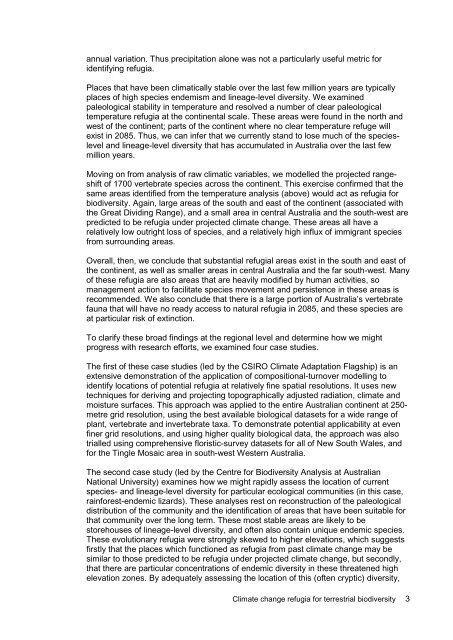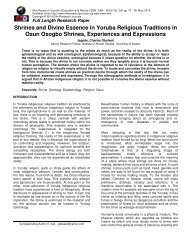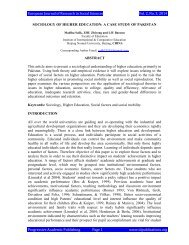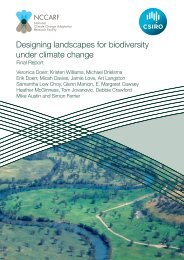Williams-Climate-change-refugia-for-terrestrial-biodiversity_0
Williams-Climate-change-refugia-for-terrestrial-biodiversity_0
Williams-Climate-change-refugia-for-terrestrial-biodiversity_0
You also want an ePaper? Increase the reach of your titles
YUMPU automatically turns print PDFs into web optimized ePapers that Google loves.
annual variation. Thus precipitation alone was not a particularly useful metric <strong>for</strong><br />
identifying <strong>refugia</strong>.<br />
Places that have been climatically stable over the last few million years are typically<br />
places of high species endemism and lineage-level diversity. We examined<br />
paleological stability in temperature and resolved a number of clear paleological<br />
temperature <strong>refugia</strong> at the continental scale. These areas were found in the north and<br />
west of the continent; parts of the continent where no clear temperature refuge will<br />
exist in 2085. Thus, we can infer that we currently stand to lose much of the specieslevel<br />
and lineage-level diversity that has accumulated in Australia over the last few<br />
million years.<br />
Moving on from analysis of raw climatic variables, we modelled the projected rangeshift<br />
of 1700 vertebrate species across the continent. This exercise confirmed that the<br />
same areas identified from the temperature analysis (above) would act as <strong>refugia</strong> <strong>for</strong><br />
<strong>biodiversity</strong>. Again, large areas of the south and east of the continent (associated with<br />
the Great Dividing Range), and a small area in central Australia and the south-west are<br />
predicted to be <strong>refugia</strong> under projected climate <strong>change</strong>. These areas all have a<br />
relatively low outright loss of species, and a relatively high influx of immigrant species<br />
from surrounding areas.<br />
Overall, then, we conclude that substantial <strong>refugia</strong>l areas exist in the south and east of<br />
the continent, as well as smaller areas in central Australia and the far south-west. Many<br />
of these <strong>refugia</strong> are also areas that are heavily modified by human activities, so<br />
management action to facilitate species movement and persistence in these areas is<br />
recommended. We also conclude that there is a large portion of Australia’s vertebrate<br />
fauna that will have no ready access to natural <strong>refugia</strong> in 2085, and these species are<br />
at particular risk of extinction.<br />
To clarify these broad findings at the regional level and determine how we might<br />
progress with research ef<strong>for</strong>ts, we examined four case studies.<br />
The first of these case studies (led by the CSIRO <strong>Climate</strong> Adaptation Flagship) is an<br />
extensive demonstration of the application of compositional-turnover modelling to<br />
identify locations of potential <strong>refugia</strong> at relatively fine spatial resolutions. It uses new<br />
techniques <strong>for</strong> deriving and projecting topographically adjusted radiation, climate and<br />
moisture surfaces. This approach was applied to the entire Australian continent at 250metre<br />
grid resolution, using the best available biological datasets <strong>for</strong> a wide range of<br />
plant, vertebrate and invertebrate taxa. To demonstrate potential applicability at even<br />
finer grid resolutions, and using higher quality biological data, the approach was also<br />
trialled using comprehensive floristic-survey datasets <strong>for</strong> all of New South Wales, and<br />
<strong>for</strong> the Tingle Mosaic area in south-west Western Australia.<br />
The second case study (led by the Centre <strong>for</strong> Biodiversity Analysis at Australian<br />
National University) examines how we might rapidly assess the location of current<br />
species- and lineage-level diversity <strong>for</strong> particular ecological communities (in this case,<br />
rain<strong>for</strong>est-endemic lizards). These analyses rest on reconstruction of the paleological<br />
distribution of the community and the identification of areas that have been suitable <strong>for</strong><br />
that community over the long term. These most stable areas are likely to be<br />
storehouses of lineage-level diversity, and often also contain unique endemic species.<br />
These evolutionary <strong>refugia</strong> were strongly skewed to higher elevations, which suggests<br />
firstly that the places which functioned as <strong>refugia</strong> from past climate <strong>change</strong> may be<br />
similar to those predicted to be <strong>refugia</strong> under projected climate <strong>change</strong>, but secondly,<br />
that there are particular concentrations of endemic diversity in these threatened high<br />
elevation zones. By adequately assessing the location of this (often cryptic) diversity,<br />
<strong>Climate</strong> <strong>change</strong> <strong>refugia</strong> <strong>for</strong> <strong>terrestrial</strong> <strong>biodiversity</strong> 3






